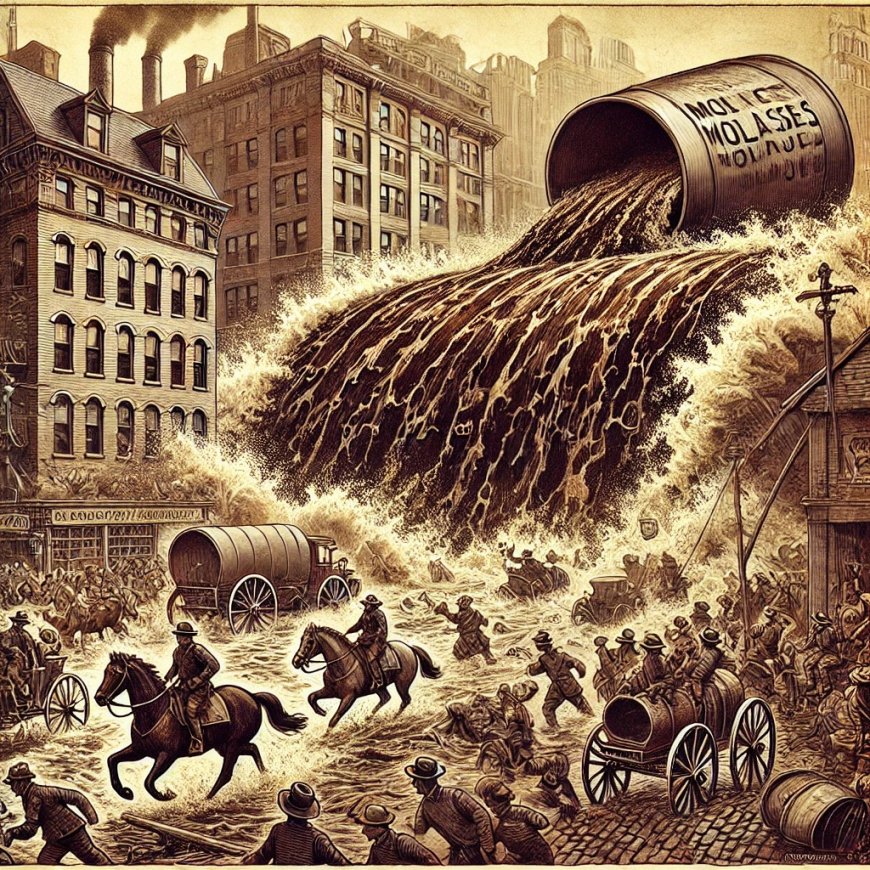The Great Molasses Flood of 1919: The Sweet Disaster That Drowned Boston in Chaos
In 1919, a giant molasses tank burst in Boston, unleashing a sticky tsunami that killed 21 people and injured 150. Discover the bizarre story of how a sugary wave of death changed a city forever.

The Sweetest Disaster No One Saw Coming
When we think of deadly disasters, we imagine earthquakes, hurricanes, or perhaps volcanic eruptions. But in January 1919, the city of Boston faced a catastrophe so bizarre, so sticky, and so unthinkable, it remains one of the strangest chapters in modern history: The Great Molasses Flood.
Yes, you read that correctly. Not fire. Not war. Not even ice. Molasses.
A tidal wave of thick, brown syrup surged through the streets of Boston’s North End, crushing buildings, sweeping away horses, and tragically killing 21 people while injuring over 150. It sounds like the stuff of satire, but it was deadly real.
The Build-Up: A Tank Too Big for Its Bolts
The United States Industrial Alcohol Company had built a massive storage tank on Commercial Street to hold molasses imported from the Caribbean. This wasn’t just for pancakes and cookies — molasses was big business in 1919. It was used to produce ethanol, which was essential for making munitions during World War I and also a key ingredient for alcohol production (at a time when Prohibition was just around the corner).
The tank was monstrous: 50 feet tall, 90 feet wide, and holding 2.3 million gallons of molasses. But there was a problem. Locals complained that the tank leaked from the very beginning. Children even collected molasses drips in tin cans. Rather than fix it, the company painted it brown to hide the leaks.
A sticky time bomb was ticking in the heart of Boston.
January 15, 1919: The Day the Streets Ran Sweet
At about 12:30 p.m. on January 15, the unthinkable happened. With a thunderous roar, the giant molasses tank burst apart. Eyewitnesses described it as sounding like machine gun fire — the rivets popping out one by one. Then came the tsunami.
A 25-foot-high wave of molasses rushed through the narrow streets of the North End at speeds of up to 35 miles per hour. Imagine a wall of sticky, brown syrup moving faster than a horse could gallop. Entire buildings were knocked off their foundations. The elevated train tracks bent like toy rails. Horses were swallowed alive. People who couldn’t run fast enough were simply engulfed, trapped in the gluey mess.
One survivor recalled:
“The wave seemed to grow bigger and bigger as it came down Commercial Street. It was like the end of the world, but made of molasses.”
A Sticky Struggle for Survival
Molasses is about eight times denser than water. Once you’re in it, getting out is nearly impossible. Many victims weren’t crushed by the wave itself, but by suffocating in the thick syrup as it cooled and hardened. Rescuers struggled to pull survivors free, their boots and clothing glued in place.
Firefighters, police, the Red Cross, and even off-duty sailors rushed in to help. The scene was nightmarish: people screaming, horses neighing, and rescuers hacking away at hardened syrup with axes. The cold January air only made things worse, turning the molasses into a thick, sticky cement.
Despite the chaos, many Bostonians also remembered the overwhelming, sickly-sweet smell that lingered in the air. For weeks, the entire city reeked of molasses.
The Cleanup: A City Buried in Syrup
The cleanup operation was almost as legendary as the flood itself. Crews used saltwater pumps, sand, and fire hoses to wash away the goo. Workers tracked molasses everywhere — on their boots, clothes, and equipment — spreading the sticky mess onto subway platforms, telephone booths, and even into nearby offices.
The Boston Harbor reportedly ran brown for months. Even decades later, residents swore that on hot summer days, the smell of molasses would rise from the cracks in the North End’s sidewalks.
Who Was to Blame?
The lawsuits began almost immediately. Over 100 claims were filed against the United States Industrial Alcohol Company. After years of courtroom battles, the company was found liable. Investigations revealed that the tank was poorly designed and never properly tested. It had been filled to near capacity despite obvious flaws.
The company had to pay $628,000 in damages (about $9 million today). Families of the victims received around $7,000 each, a meager sum compared to their loss.
Weird Facts About the Molasses Disaster
-
The wave of molasses moved faster than most people could run.
-
Victims were found stuck in syrup “as if embedded in amber.”
-
The elevated train almost collapsed, but a quick-thinking operator managed to stop it in time.
-
The disaster directly led to stronger engineering standards and building codes in Boston.
-
Even in the 21st century, Boston locals still tell stories about finding sticky residue in basements near the flood zone.
The Sticky Legacy
Today, the Great Molasses Flood is remembered with a mix of horror and dark humor. On one hand, it’s absurd to imagine an entire neighborhood drowning in molasses. On the other hand, for those who lived through it, it was a tragedy as real and devastating as any fire or storm.
It reminds us that sometimes, the strangest things can become deadly when mixed with negligence, greed, and a disregard for safety. Boston learned that lesson the hard way in 1919.
Next time you drizzle syrup on your pancakes, remember: in Boston, molasses once wasn’t a topping — it was a tidal wave of death.
Final Takeaway:
The Great Molasses Flood remains one of the weirdest and most tragic industrial accidents in history. It wasn’t just a sticky mess; it was a wake-up call that shaped building regulations and safety standards for decades to come.
What's Your Reaction?








































